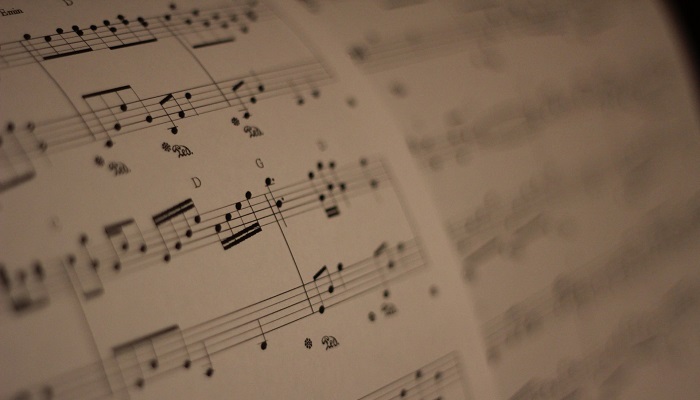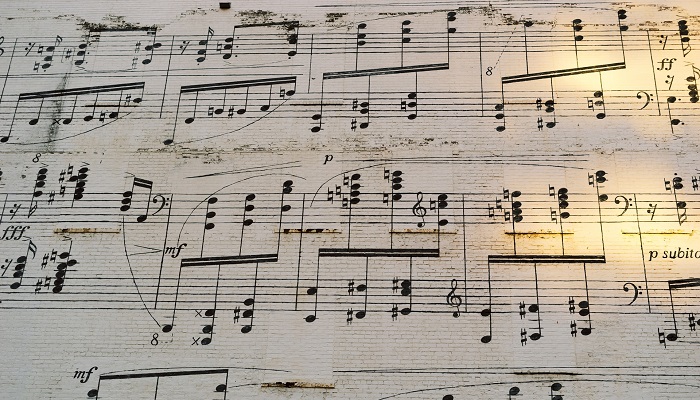Have you ever taken a closer look at members of an orchestra while they play music? Those incredibly talented individuals can read music by only taking a glance at a few sheets. But is it really that simple?
What is music notation, and how does it translate to sounds that musicians recognize instantly?
If you’ve ever asked yourself these questions, it may be time for you to get answers. In this article, we’ll explore the history behind musical notation, its types, symbols, and more.
What Is Music Notation?
As the name suggests, music notation is a series of symbols, markings, and sometimes, numbers that inform musicians how to perform a piece of music.
Much like an instruction manual, music notation is printed on sheets to give each musician directions on how to play. It has information on which notes to play, how fast or slow to hit them, and more.
The History of Music Notation
Humans have managed to write music for more than 3,000 years, which is mind-blowing! Of course, the notation system has changed drastically since then, but many elements are still known to this day.
Now, let’s take a look at the evolution of musical notations.
According to studies, it all started in ancient Mesopotamia, where scientists found clay tablets dating back to 1400 B.C. These tablets contained information on diatonic scales and harmonies in thirds.
However, the origin of western music notation dates back to Ancient Greek, which was standard from the sixth century B.C. to the fourth century A.D. Even with the rise of the Roman Empire, this music notation remained the same.
As the Byzantine Empire took control of the region, a new notation system was born, known as solfege. According to experts, solfege is the act of assigning certain syllables to different notes or scale degrees.
While the Byzantine Empire didn’t use this system to document their music, this type of music notation originated in that area.
As the years went by, musical notation slowly blossomed to the form that we see today in sheet music. It’s all thanks to the Italian monk Guido d’Arezzo, who started notating music on a staff.
Then, staff notation kept evolving throughout the late Middle Ages, the Renaissance, and all the way to the Baroque period. Many musicians today can read sheet music from the Baroque times since the format is pretty similar to the one they use nowadays.
These days, music notation has branched into five categories. Let’s get to know them better in the following section.
The Types of Music Notation

Because of the difference in music genres as well as other factors, music notation has split into five types.
Standard Notation on 5-Line Musical Staves
This is the most common form of music notation, especially in classical music. It’s almost the same method that Baroque musicians used to write music.
The rest of the music notation types have simply stemmed from this standard notation in unique ways to make reading them easier.
Lead Sheets
Lead sheets are favored by jazz musicians, and many pop and rock artists prefer them as well. This type of music notation also includes 5-line musical staves.
The only difference here is that lead sheets have the melody written on those 5 lines. Plus, the chords are documented using a letter-and-number-based notation.
Some rock guitar players like to use lead sheets, but the majority of them go for guitar tablature instead. So, what makes tablature so special in comparison to lead sheets?
Guitar Tablature
A tablature, or tabs, as many people like to call it, focuses on instrument fingering instead of musical pitches. In other words, it tells you where to press or pull the strings on a guitar, bass guitar, lute, or more.
It’s much more simple than the previous two notation forms, and it’s quicker to understand for guitarists. As a result, many musicians admire it for being time-saving when compared to other, more complex notation types.
Ultimately, it matches the fast-paced musical style of a rocker and speeds up the music-making process.
Graphic Notation

Graphic notation is another type of music writing that uses standard 5-line notation as a base. As the name implies, it blends standard notation with illustrations, which many avant-garde twentieth-century composers liked to do.
Sometimes, a composer won’t use the standard notation at all, replacing it with pictures and symbols. Some will even go as far as using words to explain the exact notes, time signature, and other information to the musicians.
The reason why many composers resorted to graphic notation is that it’s pretty simple to understand. It requires no extensive knowledge of the different symbols of the standard musical notation.
Plus, graphic notation is easier to write down since it has no rules. It goes as far as the composer’s imagination will allow!
Bar-based MIDI Notation
Last but not least, the bar-based MIDI notation is the one you’d find on a computer screen. Created with music software, this type of notation has been founded to simplify digital music-making.
MIDI notation is mostly used by film composers who need to arrange large musical scores. The funny thing is that the majority of classical musicians are only experienced in standard 5-line notation.
Therefore, film score composers usually have to translate MIDI notation to the standard form so that the musicians can play it.
Now, why don’t we dive a little deeper and give you some insight into the world of musical symbols? Let’s start by learning the notes you’d find on sheet music.
What Are the Names of Notes on Musical Staff?
Western music consists of twelve musical notes that you should know about if you wish to extend your knowledge in this field. Here they are:
- C
- C# or Db
- D
- D# or Eb
- E
- F
- F# or Gb
- G
- G# or Ab
- A
- A# or Bb
- B

As you might’ve noticed, some notes have two names, but they still produce the same pitch. For instance, when you play the piano, the key for C# and Db is one and the same. So, when do you use C# or Db when you write music?
The name that you choose for your note depends on the scale you’re in. For example, C# lies in the A major scale. You can also hear this pitch in the Bp minor scale, but, then, you’ll have to refer to it as Db.
A Brief Introduction to Musical Symbols
Of course, it takes a lot of practice and studying to memorize all the symbols that the staff-based notation consists of. Still, we’d like to give you some insight into these markings to feed your curiosity.
Before we begin, you should know that the standard musical notation consists of bar lines, clefs, noteheads, and time signatures. Sure, there are more elements, but the ones we’ve mentioned are the most important. So, let’s get to know them better!
Bar Lines
Bar lines are found on ledger lines to differentiate musical measures. The most common types of bar lines used in music notation are:
- Single bar lines: They separate one musical measure from another
- Double bar lines: They separate sections inside a musical piece
- Bold double bar lines: They mark the end of a musical movement or piece
Musical Clefs
In the world of sheet music, you’ll find three types of clefs.
- The treble clef: Notes in this clef are usually played by the right hand on the piano
- The bass clef: Notes in this clef are played by the left hand
- The C clef: A movable clef that’s often used with the viola, double bass, or bassoon
Musical Notes

If you’ve ever played an instrument, you’ve probably noticed that you can control the duration of each note. To translate the duration of each note on sheet music, notes of different lengths are written in different ways.
For instance, the first type of musical note is a whole note, which covers an entire 4-beat measure. This note uses the shape of an open notehead with no stem.
Next, you’ve got a half note, which lasts for half of a 4-beat measure. The symbol for a half note is an open notehead with a stem. Then, a quarter note covers one-quarter of a 4-beat measure, containing a closed notehead with a stem.
Of course, you can keep going this way until you reach smaller subdivisions, such as eighth notes, sixteenth notes, and so on.
Time Signatures
In music notation, time signatures are indicators of two things:
- The duration of each beat in a measure of music
- The number of beats in each measure
For instance, the time signature ¾ implies that there are three beats per measure. Also, it indicates that each beat has a duration of a quarter-note.
However, the most popular time signature in western music is 4/4. And, because it’s widely used, people in the music industry call it ‘common time.’ For that reason, many composers refer to it by using the letter ‘C.’







